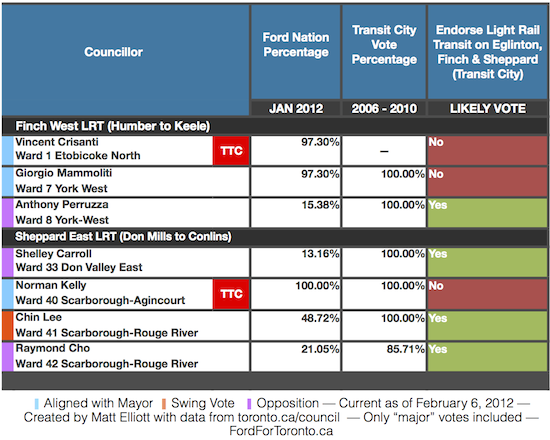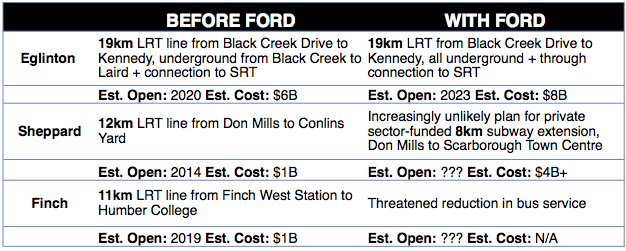
One Toronto taxpayer has a bold idea to pay for transit in Toronto
Respondent 2-625 has ideas for public transit in Toronto. Big ideas. “We could hold the first North American Electric Motorcycle Race,” writes the Toronto taxpayer. “These bikes are fast.”
Pushing for a world class racetrack up at Downsview Park, the respondent indicates that a private sector partner — like “Apple or RIM” — would sponsor a subway station connected to the race track that would host “world events in our backyard” with fast bikes and cars and so on. This, it’s said, is a “potential goldmine.”
“I can see it now,” he or she concludes, Â “no more boring expensive walkways to the train, I see a walkway that brings your senses alive before you watch million dollar cars race for the day.”
Out with the boring, bland walkways in our transit system — in with the racetrack-adjacent walkways that bring your senses alive.
Let’s hear from Toronto
Earlier this year, the City of Toronto embarked on an extensive public consultation process as a precursor to a planned Core Service Review. Over 13,000 people filled out an online survey while hundreds attended public meetings held across the city. Unfortunately, soon after the data gleaned from this process was released, high-ranking members of Mayor Rob Ford’s Executive Committee dismissed it as irrelevant. The sample was “self-selected,” said one councillor.
And, sure, okay, maybe it would be a stretch to call this data statistically sound, but it still represents the collective opinions of thousands of Torontonians. Isn’t that, by its very nature, something worth considering? Something worth exploring?
I think so, and that’s why I’m doing this: over the next few weeks, I will write brief summaries of all eleven of the Core Service Review qualitative reports. These reports contain thousands of comments written by the citizens of Toronto on a variety of topics. Today, we start with transit. (The numbers refer to the survey question, followed by the response number. All data is anonymous.)
Duh, Transit is important
Seems obvious, but let’s start here: Of the 13,000+ responses, 4,569 reported public transit (or something related to it) as one of the most important issues facing our city in 2011. Many were colourful with their description of the problem. Respondent 1-9’s major issue is listed as “Public transit sucking hard.” 1-306 writes “We need more public transit now!” Â 2-64 just writes “TRANSIT!!!!!!!” Respondent 1-509 despairs over “the rising price of TTC and the terrible service they provide,” while 1-621 is rather forceful with the belief that “the TTC is the worst transit system of any major metropolitan area in North America.”
The prevailing trend is that people are tremendously protective of the TTC and the role it plays in our urban lives, but, also, simultaneously, they despise it with the fire of a thousand suns. Customer service is noted as a major issue. Respondent 1-2404 lists, as a top issue facing the city, “seemingly deliberate, rude, ornery, poor service among TTC [and other] employees.” 3-20 points out “when you’re paying ever increasing fares on the TTC and dealing with service disruptions, filthy stations and (some) rude staff, the combination is really unappealing.”
Cost comes up a lot, with many decrying the service as already unaffordable.”The TTC relies too heavily on service fees,” says 3-79. “[It’s] to the point where the fares are completely unaffordable to those on a limited income.” 3-19 makes the case for young people in the city, writing that “$120 is a lot for a Metropass right out of university when you work part time at Indigo and have to pay $700 for a basement apartment.” 2-863 makes a strong point, and is one of many who links the cost of transit to the cost of car ownership, writing “I pay 80% of my bus trip, how much of a car trip is paid for by the user?” (The actual TTC fare box recovery ratio is closer to 70% than it is to 80%, but let’s not split hairs.)
Expansion? Yes! How? That’s up for debate!
The word “expansion” appears hundreds of times in the document, with most agreeing that more service to more places is a good idea. Less universal are opinions on where that expansion should occur, and what form it should take.
There are a ton of voices opposing the mayor’s transit ideas and calling for a return to a more David Miller-esque vision. “MORE TTC SERVICE – MORE LIGHT RAIL (EFFICIENT)…LESS SUBWAYS (COSTLY)” writes 1-355. 1-490 concurs, saying that the city shouldn’t be “building subways when LRT is much cheaper.” 1-591 worries about “borrowing 4 billion to build a useless subway” while 1-640 asks that we be “promoting realistic public transit – not the destruction of it as outlined by Ford.”
On the other side of the fence, there’s 1-469, calling for “Building subways, not high speed railways or light rapid transit.” 1-79 asks for “Decongestion of traffic, ie. via delivering promised TTC Subway extending past Morningside Ave. on Sheppard.”
All in all, responses tilt away from the Sheppard plan, with only a few mild supporters in the bunch. The fabled Downtown Relief Line gets a number of mentions, with 2-1172 calling for “Subway expansion, specifically the Downtown Relief Line NOT Sheppard!” Respondent 2-807 points out that “Downtown subway expansion such as the downtown relief line is essential prior to any extension of the Yonge line into York Region.” Otherwise, the response continues, “Torontonians will be waiting on platforms watching trains full of York Region residents pass them by.”
An overlooked piece of the transit expansion debate also emerges, as many call for better TTC service to Pearson airport. 2-509 sums it up best: “What kind of major city doesn’t have subway or above-ground train to its airport in the year 2011?”
The Ford Nation appears? Killing streetcars and privatizing transit
Response 1-509 lists their top issue facing the city in 2011 as “streetcars-replace with buses.” Similar calls are echoed throughout the report, though they are ultimately a minority voice. Response 2-3762 calls for a “move from streetcars to electric buses in downtown core.” Many indicate a belief that streetcars only make traffic worse (2-319). “Streetcars suck,” writes 2-1135, “I’m happy Ford is removing this stupid Light Rail idea and adding more subways…more! More!”
Another vocal minority calls for the contracting out of bus routes or the complete privatization of the TTC. 3-571 says “if you can find somewhere to contract out TTC services, somewhere that does not use a a bloated union and employees are earning outrages salaries for regular jobs, I say do it.” Much of this desire stems from a belief that TTC workers are overpaid. Respondent 3-96 believes the “salaries of TTC workers should be cut…all TTC workers have inflated salaries.”
Fighting traffic congestion with transit
The big takeaway, expressed by hundreds of people in this document, is the common belief that traffic congestion can be solved with more public transit. Response 4-505 proclaims that “Toronto is choking on traffic,” but adds that the “solution cannot be more roads.” 3-237 says that “we need to set up our city as a walkable, and transit-able city. We can’t support the traffic we have now and as the city grows it is only going to get worse.”
There is significant support amongst respondents for new revenue tools for transit, primarily road tolls and congestion charges, though many ask that they only apply to 905 residents who come into the city. Respondent 4-401 echoes a common sentiment: “Our services are used by thousands of 905ers every day who don’t necessarily contribute to paying for them.”
We’ll let 4-327 have the last word: “Congestion is ridiculous and the answer is not widening roads and providing more capacity. The answer is is providing higher order transit and alternatives to the single occupancy vehicle. Rethink your priorities please, Mayor Ford.”
Which is a fair enough point — especially considering at least one member of Ford’s Executive have gone on record with their belief that more roads will solve congestion issues –, but still, I’m thinking we should just circle back to the beginning and really work out a strategy for funding transit with electric motorcycle racing. Those bikes are fast.



